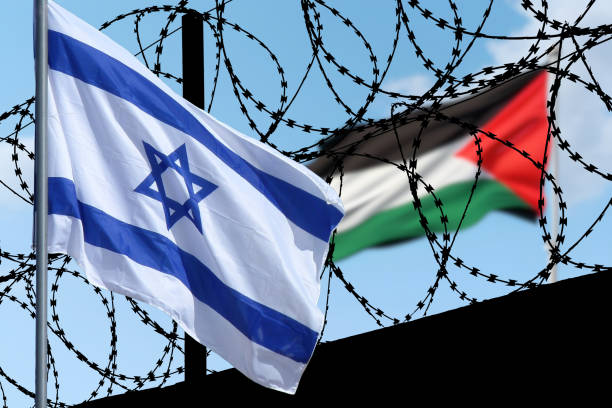Introduction
The Israel-Palestine conflict is one of the most complex and long-standing disputes in modern history, marked by deep-rooted political, religious, and territorial disagreements. Centred around the land between the Mediterranean Sea and the Jordan River, the conflict encompasses competing nationalistic aspirations: Jewish claims for a homeland in Israel and Palestinian demands for sovereignty in what they consider their ancestral territory. Over decades, it has led to wars, uprisings, and failed peace negotiations, leaving a legacy of displacement, mistrust, and suffering.
To understand the intricacies of this conflict, it is essential to delve into its historical roots, tracing back to when the region underwent transformative political, social, and demographic changes.
Historical Background
The story begins with the ancient Kingdom of Israel, where Jews lived under King Solomon’s rule around the 10th century BCE. Solomon built the First Temple in Jerusalem, known today as the Temple Mount, a sacred site for Jews. In 586 BCE, the Babylonians, led by King Nebuchadnezzar, destroyed the First Temple and exiled many Jews to Babylon. Later, the Persian Empire, under Cyrus the Great, allowed the Jews to return and rebuild the temple, which was completed in 516 BCE and called the Second Temple. However, the Romans destroyed this temple in 70 CE, forcing Jews into the Diaspora, scattering them across Europe and the Middle East. During this period, Jesus of Nazareth was born in Roman-occupied Judea. His teachings diverged from Jewish traditions, forming the foundation of Christianity. Following his crucifixion by Roman authorities, tensions grew between Christians and Jews, as some Christians blamed Jews for Jesus’ death. By the 4th century, Emperor Constantine embraced Christianity and built the Church of the Holy Sepulcher near the Temple Mount. In the 7th century, Arab armies under Caliph Umar conquered Jerusalem, building the Al-Aqsa Mosque and Dome of the Rock. These overlapping histories make Jerusalem sacred for Judaism, Christianity, and Islam, setting the stage for modern conflict.
The First World War and the Balfour Declaration
During World War I (1914-1918), Britain sought to secure the support of various groups, including Jews and Christians, as part of its broader strategy to counter the Ottoman Empire, which controlled Palestine and supported Germany. In 1917, Britain issued the Balfour Declaration, a statement expressing support for the establishment of a “national home for the Jewish people” in Palestine. This declaration was pivotal, as it recognized Jewish aspirations for a homeland while also asserting that the rights of existing non-Jewish communities in Palestine would not be prejudiced.
Following the war, the Ottoman Empire was dismantled, and the League of Nations granted Britain a mandate over Palestine in 1920. This marked the beginning of increased Jewish immigration to Palestine, with approximately 300,000 Jews migrating to the region between
1919 and 1936. Many were fleeing rising anti-Semitism in Europe, particularly with the ascent of Adolf Hitler in Germany. However, this migration and Britain’s policies caused significant discontent among the Arab population, who viewed it as a threat to their demographic and political dominance in the region. (Balfour Declaration)
World War II and the Holocaust
The Holocaust during World War II (1939-1945) had a profound impact on the Jewish community worldwide. An estimated six million Jews were systematically murdered by the Nazi regime in concentration camps and through other means. The genocide underscored the urgent need for a safe haven for Jews and galvanized international support for the establishment of a Jewish state. At the end of World War II in 1945, the victorious Allies, including Britain, the United States, and the Soviet Union, were instrumental in the creation of the United Nations (UN). The Holocaust’s atrocities strengthened the argument for a Jewish homeland, leading to increased global advocacy for a resolution to the situation in Palestine.
The UN Partition Plan of 1947
In 1947, Britain, unable to resolve the escalating tensions between Jews and Arabs in Palestine, referred the matter to the United Nations. The UN proposed a partition plan to create two independent states—one Jewish and one Arab—while placing Jerusalem under international administration. The plan was endorsed by major powers, including the United States and the Soviet Union, and was adopted by the UN General Assembly.
The establishment of Israel was declared on May 14, 1948. However, this decision was immediately rejected by Arab nations, leading to the First Arab-Israeli War in 1948. Israel, despite being newly established and facing considerable odds, emerged victorious and gained additional territory beyond the original UN partition plan. The war resulted in significant displacement, with hundreds of thousands of Palestinians becoming refugees—an issue that remains a core grievance in the Israel-Palestine conflict. (UN Partition Plan 1947)
The Suez Crisis and the Six-Day War
Tensions between Israel and its Arab neighbours continued to escalate in the following decades. Egypt, under President Gamal Abdel Nasser, sought to challenge Israel’s trade and military security. In 1956, Egypt nationalized the Suez Canal and blocked Israeli shipping. This led to the Suez Crisis, where Israel, supported by Britain and France, launched a military intervention. Although Israel withdrew under international pressure, the conflict highlighted the strategic vulnerability of the region.
The Six-Day War of 1967 further reshaped the geopolitical landscape. Triggered by Egypt’s closure of the Straits of Tiran to Israeli shipping and the mobilization of Arab forces, the war saw
Israel launch a pre-emptive strike against Egypt, Jordan, and Syria. In just six days, Israel achieved a decisive victory, capturing the Sinai Peninsula, Gaza Strip, West Bank, East Jerusalem, and Golan Heights. These territorial gains significantly altered the dynamics of the conflict, as Israel now controlled areas with large Palestinian populations, further intensifying tensions.
The Right to Exist
The Jewish connection to the land of Israel spans over 3,000 years, with Jerusalem at the core of their historical and spiritual identity. The establishment of Israel was seen as a necessary refuge for Jews worldwide, especially after the Holocaust. The United Nations’ approval of the partition plan gave legal recognition to this homeland (United Nations, 1947). However, Israel’s formation was met with immediate hostility from neighbouring Arab states, which led to wars attempting to dismantle the newly established nation.
Israel’s emphasis on its right to exist stems from its historic ties to the land and its need for security amid continuous threats. Its policies often prioritize national survival, though these actions are sometimes perceived as controversial.
Jerusalem: A City at the Centre of Conflict
Jerusalem is a focal point of the Israeli-Palestinian conflict due to its deep religious and historical significance for both Jews and Palestinians. For Jews, Jerusalem is their spiritual and historical capital, housing sites like the Western Wall. In the 1967 Six-Day War, Israel gained control of East Jerusalem and declared the entire city its undivided capital.
Despite this, the international community largely does not recognize Israel’s claim over East Jerusalem, which Palestinians consider the future capital of their state. However, Israel maintains that Jerusalem’s unity is integral to its sovereignty and security (Knesset, 2023).
The Rise of the PLO and Hamas
The territorial losses suffered by Arab states in 1967 led to the emergence of the Palestine Liberation Organization (PLO) as a key representative of the Palestinian people. The PLO, initially focused on armed struggle, sought to reclaim Palestinian lands and establish a Palestinian state. However, its efforts were often undermined by internal divisions and external opposition.
In the late 20th century, the rise of Hamas introduced a new dimension to the conflict. Founded in 1987 during the First Intifada (Palestinian uprising), Hamas positioned itself as an Islamist alternative to the PLO’s secular nationalism. Its stated goal of liberating all of historic Palestine and its use of violence against Israel further polarized the situation.
Palestine’s Right to Return
The Palestinian “Right of Return” refers to the right that is claimed by the Palestinian refugees and their descendants who were displaced during the Arab-Israeli War (also known as the Nakba to Palestinians) in 1948 and the 1967 Six-day War have a right to return to their former homes in what is now Israel. This claim is deeply rooted in historical events and the various interpretations of international law.
Legal and Historical Dimensions
The displacement of Palestinians, which began during the 1947–1949 conflict, led to the creation of a substantial refugee population. The United Nations General Assembly adopted Resolution 194 in 1948, which stated that refugees wishing to return to their homes and live in peace with their neighbors should be permitted to do so at the earliest practicable date. In international law, the right of return is often associated with principles enshrined in documents like the Universal Declaration of Human Rights, which in Article 13 states that everyone has the right to leave any country, including their own, and to return to their country. Scholarly analyses suggest that the Palestinian right of return can be legally justified due to its status as customary law and its broad applicability on both an individual and collective basis. Source
PLO’s Stance:
As the internationally recognized representative of the Palestinian people since its formation in 1964, the PLO has consistently advocated for the rights of Palestinian refugees displaced in 1948 and 1967 to return to their original homes. The PLO has emphasized that this right applies not only to the original refugees but also to their descendants, framing it as a multi-generational right tied to Palestinian identity and sovereignty. Their approach to the Right to Return has evolved in response to political realities and negotiations, particularly after the Oslo Accords (1993). While the principle remains central to the PLO’s political agenda, the organization has demonstrated a pragmatic willingness to explore solutions that could balance Palestinian aspirations with the realities of negotiation. In negotiations, the PLO has advocated for a combination of solutions, including:
1) The voluntary return of a limited number of refugees to areas within Israel.
2) Compensation for those who choose not to return or cannot return.
3) Resettlement in a future Palestinian state or third countries. JSTOR
Hamas’s Stance:
Hamas, an Islamist Palestinian organization founded in 1987 during the First Intifada, strongly upholds the Palestinian Right to Return as an inalienable and non-negotiable principle. Unlike the PLO, which has demonstrated some flexibility in negotiations, Hamas adopts a more uncompromising stance, viewing the right as sacred and fundamental to the Palestinian cause. It also rejects any agreements that do not explicitly recognize the refugees’ right to return to their original homes within the boundaries of pre-1948 Palestine. Hamas frames the Right of Return within its broader Islamist vision, asserting that all of historic Palestine is waqf (Islamic trust land) and must remain under Muslim sovereignty. Hamas’s 2017 policy document emphasizes that the right of return is a holy and collective right that any individual or entity cannot relinquish. The document also rejects any proposals that would undermine this right, such as resettlement or compensation in lieu of return. They criticized the Oslo Accords and subsequent negotiations for side-lining refugee rights accusing the PLO of abandoning core Palestinian principles and using armed resistance as a legitimate and necessary tool to achieve the Right of Return. Wilson Centre
Understanding Israel’s Stance and its Struggle for Existence
The establishment of Israel in 1948 was a result of Jewish aspirations for a homeland after centuries of persecution, culminating in the horrors of the Holocaust. The foundation of the state was legally supported by the Balfour Declaration in 1917 and the United Nations Partition Plan of 1947, which proposed separate Jewish and Arab states. However,
Israel’s existence and policies remain a topic of international debate and controversy, especially regarding its conflicts with Palestine. Israel argues that allowing millions of Palestinian refugees and their descendants to return to areas within Israel would fundamentally alter the country’s demographic balance, threatening its Jewish majority. The Jewish Nation-State Law (2018) further solidified its stance on the refugee issue. Israel views the Right of Return as incompatible with its sovereignty. Its officials argue that many Jews were also displaced from Arab countries after 1948, creating a parallel narrative of forced migration. The country also disputes the 194 resolution and argues that the resolution was non-binding and contingent on refugees’ willingness to live peacefully, which it claims was not demonstrated. Source
Criticism of Israel’s Military Actions
Israel’s military actions in Gaza and the West Bank have drawn criticism from international organizations and human rights groups. Operations like “Protective Edge” in 2014 resulted in significant civilian casualties, prompting accusations of war crimes (B’Tselem). The blockade of Gaza, combined with the expansion of settlements in the West Bank, has also been criticized as a violation of international law. Israel defends its military actions as necessary to protect its citizens from groups like Hamas, which frequently launch rockets and use civilian areas as shields (BBC News, 2021). The country asserts that Its operations target terrorist activities, though it acknowledges the tragic consequences for civilians.
Defending Sovereignty and Seeking Peace
Israel argues that its right to exist is independent of its policies. Its foundation was intended as a haven for Jews, a necessity born from centuries of persecution. The nation has consistently emphasized that achieving peace requires mutual recognition and accountability from all sides. Israel continues to call for coexistence and a two-state solution, which balances its security needs with Palestinian aspirations for statehood. However, progress remains stalled due to deep mistrust and unresolved disputes over borders, refugees, and Jerusalem.
Conclusion
The Israel-Palestine conflict has had devastating humanitarian, economic, and political consequences, deeply affecting both sides and the broader Middle East. The recent ceasefire has allowed over 300,000 displaced Palestinians to return home, but many have found their neighbourhoods in ruins, requiring urgent reconstruction. While the ceasefire has facilitated humanitarian aid and hostage releases, long-term peace remains uncertain.
The war has led to thousands of casualties, severe economic downturns, and the destruction of critical infrastructure. It has also fuelled regional instability, strained international relations, and intensified global political divisions. The humanitarian crisis, especially in Gaza, continues to demand urgent intervention. Despite diplomatic efforts, deep-seated tensions persist, making a lasting resolution challenging.
Moving forward, rebuilding efforts, sustained peace negotiations, and international support will be crucial in achieving stability. A long-term solution requires mutual recognition, security assurances, and policies that prioritize coexistence, justice, and humanitarian relief for both Israelis and Palestinians.
Article written by
Vaibhav Puri, Prachi Gandas, Aarya Kale and Siddhavi Arsekar



